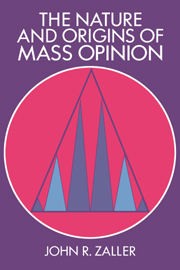Book contents
- Frontmatter
- Contents
- List of tables and figures
- Preface
- 1 Introduction: The fragmented state of opinion research
- 2 Information, predispositions, and opinion
- 3 How citizens acquire information and convert it into public opinion
- 4 Coming to terms with response instability
- 5 Making it up as you go along
- 6 The mainstream and polarization effects
- 7 Basic processes of “attitude change”
- 8 Tests of the one-message model
- 9 Two-sided information flows
- 10 Information flow and electoral choice
- 11 Evaluating the model and looking toward future research
- 12 Epilogue: The question of elite domination of public opinion
- Measures appendix
- References
- Index
7 - Basic processes of “attitude change”
Published online by Cambridge University Press: 05 June 2012
- Frontmatter
- Contents
- List of tables and figures
- Preface
- 1 Introduction: The fragmented state of opinion research
- 2 Information, predispositions, and opinion
- 3 How citizens acquire information and convert it into public opinion
- 4 Coming to terms with response instability
- 5 Making it up as you go along
- 6 The mainstream and polarization effects
- 7 Basic processes of “attitude change”
- 8 Tests of the one-message model
- 9 Two-sided information flows
- 10 Information flow and electoral choice
- 11 Evaluating the model and looking toward future research
- 12 Epilogue: The question of elite domination of public opinion
- Measures appendix
- References
- Index
Summary
Within the RAS model, “attitudes,” in the conventional sense of the term, do not exist. Rather, people make “attitude reports” or “survey responses” on the basis of momentarily salient considerations. Attitude change, then, cannot be understood within the RAS model as a conversion experience, the replacement of one crystallized opinion structure by another. It must instead be understood as a change in the balance of positive and negative considerations relating to a given issue. To model it, one must represent the process by which new considerations are added to the pool of existing considerations in the person's mind, thereby permanently altering long-term response probabilities on the issue. Permanent alterations in long-term response probabilities are the RAS model's equivalent of attitude change. Since this phrase is a cumbersome one, my discussion of the phenomenon will retain the more standard locution, attitude change. However, the reader should keep in mind that I am using it as a phrase of convenience, and am actually referring to an alteration in long-term response probabilities that has been brought about by the acquisition of new considerations.
Attitude change, understood in this way, makes an enormously more interesting subject of study than cross-sectional opinion. When adequate opinion data are available, as they are in a handful of cases, the analyst is no longer forced to infer a dynamic process from a static distribution of opinion, as was done in Chapter 6, but can directly observe the processes that are shaping opinion.
- Type
- Chapter
- Information
- The Nature and Origins of Mass Opinion , pp. 118 - 150Publisher: Cambridge University PressPrint publication year: 1992



